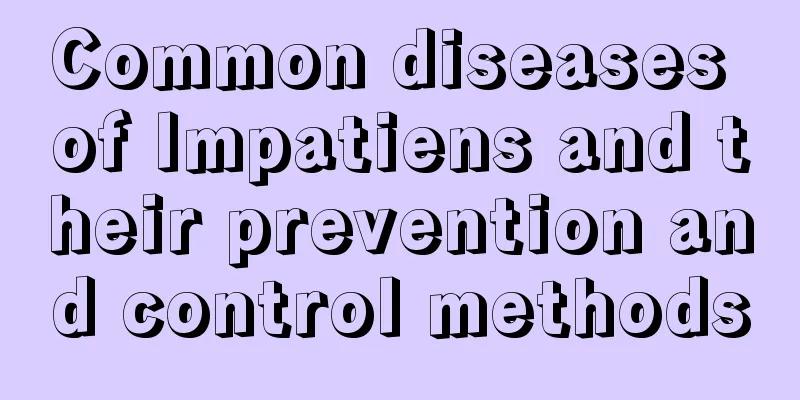Common diseases of Impatiens and their prevention and control methods

Common diseases of Impatiens: Powdery mildewSymptoms: Powdery mildew of Impatiens mainly harms leaves, but can also spread to young stems, flowers and fruits. The infected leaves initially have sporadic irregular white powdery patches on their surface. As the disease progresses, the leaf surface is gradually covered with a layer of white powder. In early autumn, small yellow dots form in the white powder layer, and then gradually turn darker to dark brown. The diseased leaves turn yellow and twisted in the later stage. Prevention and control methods: Strengthen cultivation management, the planting density should be appropriate, there should be sufficient ventilation and light conditions, apply more phosphorus and potassium fertilizers, and do not apply excessive nitrogen fertilizers. Remove diseased plants and leaves promptly and burn them in batches to reduce the source of infection next year. During the disease period, spray with 2000-3000 times diluted 25% triadimefon wettable powder, 1000-1200 times diluted 70% thiophanate-methyl wettable powder, or 500 times diluted 25% carbendazim wettable powder. Common diseases of Impatiens: Brown spot diseaseSymptoms: The disease mainly occurs on the leaves. The leaf spots initially appear as light yellow-brown dots, then expand into circles or ovals, and later turn light brown in the center and brown at the edges with inconspicuous rings. On severely diseased leaves, the spots form in patches, causing the leaves to turn yellow and eventually die. Prevention and control methods: Impatiens prefers fertile sandy loam and is not tolerant to waterlogging. Therefore, sandy loam is suitable for planting to facilitate drainage; for potted Impatiens, the pots should be turned over in time after rain. Diseased leaves and plants should be destroyed in batches in late autumn to reduce the source of infection in the next year. In the early stage of the disease, use 300-600 times diluted 25% carbendazim wettable powder, 100 times diluted 50% thiophanate-methyl, or 1000 times diluted 75% thiophanate-methyl for prevention and control. Common diseases of Impatiens: Damping-offSymptoms: The pathogen mainly infects the rhizomes, causing the diseased parts to turn black or constrict, and white mold to grow on them when it is humid. After the plant is infected, the leaves will wilt and dry up within a few days, leading to the death of the entire plant. Prevention and control methods: After removing the diseased plants at the early stage of the disease, spray 600 times diluted 75% thiophanate-methyl wettable powder, or 500 times diluted 60% dolphate wettable powder, or 1200 times diluted 20% methyl tolclofos emulsifiable concentrate. Common diseases of Impatiens: Ring rotSymptoms: Impatiens ring rot damages the leaves of Impatiens, causing large circular spots with dark brown edges around the leaves. There are obvious concentric rings on the surface of the lesion. In the later stage, the middle part of the lesion turns gray-brown, with scattered small black spots. Prevention and control methods: Start spraying the medicine at the early stage of the disease, spray once every 7 to 10 days, and spray 2 to 3 times in a row. Commonly used agents include: 800 times diluted 50% thiram wettable powder; 600 times diluted 65% mancozeb wettable powder or 75% thiophanate-methyl wettable powder; 1000 times diluted 50% carbendazim wettable powder, etc. |
<<: Common diseases of Catharanthus roseus and their control methods
>>: Diseases and pests of Polygonum multiflorum and their control methods
Recommend
How to care for Michelia before it blooms
1. Specific period This plant will bloom from Mar...
What plants are suitable for sowing in June?
Flowers suitable for sowing in June In June, most...
Prevention and control measures of sheep pasteurellosis
Sheep pasteurellosis is caused by Pasteurella mul...
How to water with Gold Finger
How to water the Golden Finger in spring As the t...
Four seasons maintenance methods of shrimp flower
Spring and Autumn Maintenance of Shrimp Flower Be...
What is the flower language of Huang Li?
Huang Li's Flower Language Cheerful and Happy...
How to propagate succulents and what to pay attention to
How to propagate succulents There are many ways t...
How to grow golden diamond in autumn
1. Suitable temperature Generally speaking, the m...
How to grow Metasequoia bonsai
soil Metasequoia prefers warm and humid climatic ...
How to grow hydrangea in summer
1. Lighting: This plant is not particularly light...
Does osmanthus like the sun?
Osmanthus loves the sun Osmanthus likes sunlight ...
How to trim Jasper
When is the best time to trim Jasper? Jade grows ...
When does the white pine bloom?
When does it bloom? Under natural conditions, the...
What is the language of water lilies and what does it mean to send them as gifts?
1. Flower Language The flower language of water l...
Can lucky bamboo be grown with purified water? Can lucky bamboo be grown with tap water?
1. Can I use purified water? Lucky bamboo can be ...









